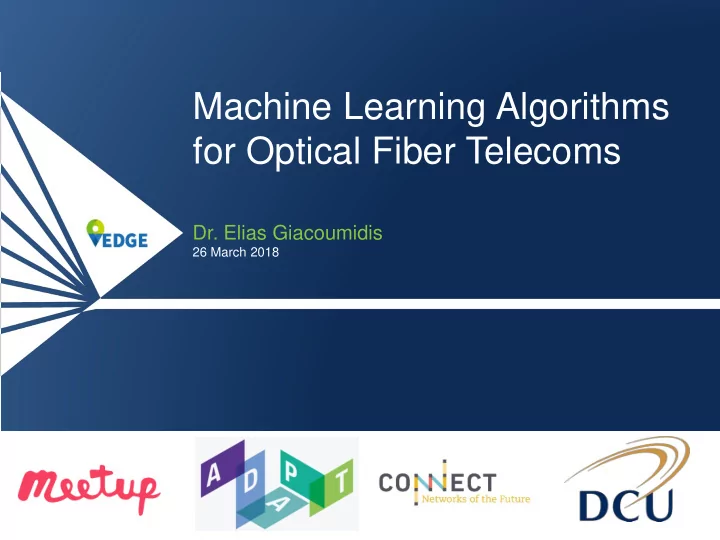

Machine Learning Algorithms for Optical Fiber Telecoms Dr. Elias Giacoumidis 26 March 2018
Personal background Bangor University, Wales, UK (PhD) Optical transmission for >40-Gb/s local and access networks Athens Information Technology centre, Athens, Greece Passive optical networks (PONs) Telecom Paris-Tech, France (collaboration with France Telecom-Orange Labs) Coherent optical communications for >100-Gb/s multi-channels Aston University, UK Digital signal processing (DSP)-based fibre nonlinearity compensation University of Sydney, Sydney, Australia Machine learning DSP for optical commun. and photonic-chip applications Dublin City University (DCU), Ireland (visiting researcher at Xilinx-Ireland) Real-time machine learning DSP for optical communications
Machine learning for optical communications
Photonics: machine learning under the spotlight
Typical optical communication system
DSP importance in optical communications
Constellation diagrams for modulation
DSP receiver design with machine learning DSP Receiver processing: Synchronization Optical carrier frequency offset compensation Linear Equalization & Machine Learning Data Recovery
Clustering-based machine learning K-means Fuzzy-logic c-means
K-means: Step 1 Phase Modulator OCDMA setup Algorithm: k-means, Distance Metric: Euclidean Distance 5 expression in condition 2 4 k 1 3 k 2 2 1 k 3 0 0 1 2 3 4 5 expression in condition 1
K-means: Step 2 Phase Modulator OCDMA setup 5 expression in condition 2 4 k 1 3 k 2 2 1 k 3 0 0 1 2 3 4 5 expression in condition 1
K-means: Step 3 Phase Modulator OCDMA setup 5 expression in condition 2 4 k 1 3 2 k 3 k 2 1 0 0 1 2 3 4 5 expression in condition 1
K-means: Step 4 Phase Modulator OCDMA setup 5 expression in condition 2 4 k 1 3 2 k 3 k 2 1 0 0 1 2 3 4 5 expression in condition 1
K-means: Step 5 Phase Modulator OCDMA setup 5 expression in condition 2 4 k 1 3 2 k 2 k 3 1 0 0 1 2 3 4 5 expression in condition 1
Fuzzy-logic c-means Phase Modulator OCDMA setup Single-dimensional data x MD: Membership Degree MD MD Hard clustering Fuzzy clustering 1 1 x 0 x 0
Received constellation diagrams for 16-QAM No equalization Linear equalization - Machine learning - hard decision soft decision/nonlinear boundaries boundaries
Alternative design for 16 clusters Step 2: 4 groups of 4 clusters Step 1: large group of 4 clusters CASE-1 I I Q Q Single-step: 1 group of 4 clusters & 6 groups of 2 clusters CASE-2 I
Shapes of constellation diagrams
Transceiver setup Electrical Transmitter Electrical Receiver Digital-to- Analogue- DSP DSP receiver with Analogue to-Digital transmitter machine learning Conversion Conversion
Nonlinear distortion
Ƹ Artificial Neural Network design ANN: Artificial Neural Network 𝜒 𝑙,𝑗 𝑦 = nonlinear transformations of subcarrier k e k = s(k) − ො s(k) N = level of constellation mapping w = weights 𝑂 e = error 𝑡 𝑙 = 𝑥 𝑙,𝑗 𝜒 𝑙,𝑗 (𝑡 𝑙 ) s = signal MMSE = minimum-mean square-error 𝑗=1
Why machine learning is good for us? Deterministic techniques Machine Learning tackles stochastic noises in optical networks without knowledge of the fibre link parameters ( versatile learning ). It has benefit over wireless systems because optical link has stable parameters. [1] E. Giacoumidis et al, OSA Opt. Let. 12 , 123 (2016) [2] E. Giacoumidis et al, IEEE JLT 10, 234 (2017) Complexity comparison (Number of operations) Deterministic techniques
Comparison with benchmark technologies
Crucial points Real-time signal processing on FPGA areas where errors are most likely
3D deep learning?
Thank you for your attention !!!
Recommend
More recommend